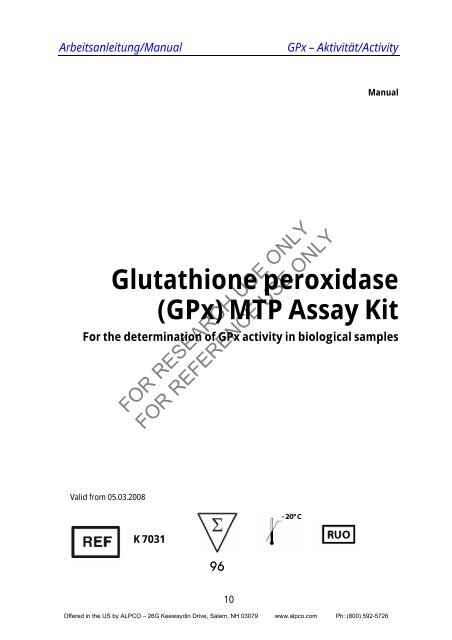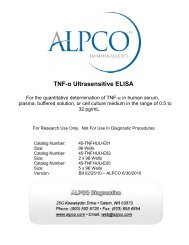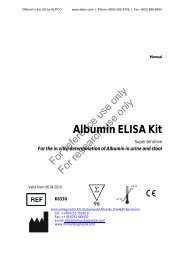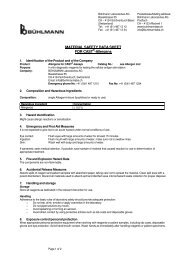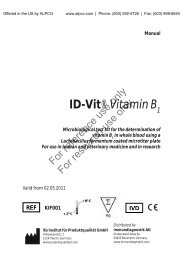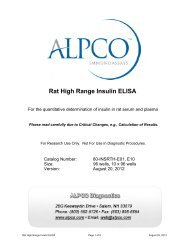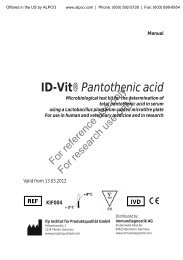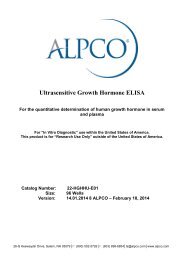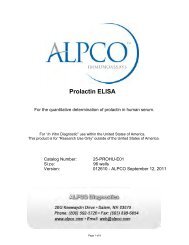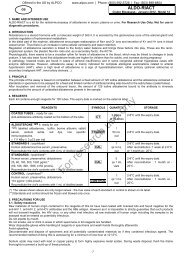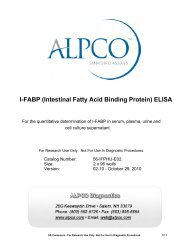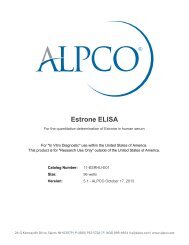Glutathione peroxidase (GPx) MTP Assay Kit
Glutathione peroxidase (GPx) MTP Assay Kit
Glutathione peroxidase (GPx) MTP Assay Kit
Create successful ePaper yourself
Turn your PDF publications into a flip-book with our unique Google optimized e-Paper software.
Arbeitsanleitung/Manual<strong>GPx</strong> – Aktivität/ActivityManual<strong>Glutathione</strong> <strong>peroxidase</strong>(<strong>GPx</strong>) <strong>MTP</strong> <strong>Assay</strong> <strong>Kit</strong>For the determination of <strong>GPx</strong> activity in biological samplesFOR RESEARCH USE ONLYFOR REFERENCE USE ONLYValid from 05.03.2008K 70319610Offered in the US by ALPCO – 26G Keewaydin Drive, Salem, NH 03079 www.alpco.com Ph: (800) 592-5726
Arbeitsanleitung/Manual<strong>GPx</strong> – Aktivität/Activity1. INTENDED USEThe <strong>Glutathione</strong> <strong>peroxidase</strong> (<strong>GPx</strong>) <strong>Assay</strong> <strong>Kit</strong> is intended for the measurementof total <strong>GPx</strong> activity. It can be used to measure <strong>GPx</strong> activity in erythrocytelysates. It is for research use only.2. INTRODUCTION<strong>Glutathione</strong> <strong>peroxidase</strong> (<strong>GPx</strong>) is one of the most important enzymes fordetoxification of peroxides in living cells. <strong>GPx</strong> plays a crucial role inprotecting cells from damage by free radicals which are formed by peroxidedecomposition. Lipid components of the cell are especially susceptible toreactions with free radicals resulting in lipid peroxidation. <strong>GPx</strong> reducesperoxides to alcohols using glutathione thus preventing the formation offree radicals.<strong>GPx</strong> enzymes catalyze the reduction of hydrogen peroxide and a widevariety of organic peroxides to water and the corresponding stable alcoholsusing cellular glutathione as the reducing reagent.Most cellular glutathione <strong>peroxidase</strong>s are tetrameric enzymes consisting offour identical 22 kDa monomers, each of which contains a selenocysteine inthe active site. The selenocysteine participates directly in electron donationto the peroxide substrate and becomes oxidized in the process. The enzymethen uses reduced glutathione as a hydrogen donor to regenerate theselenocysteine. <strong>GPx</strong> enzymes also exist as non-selenium (non-Se) containingenzymes.Cellular <strong>GPx</strong> is present in all tissues; however, various diseases may influenceits level. An increase in the level of glutathione <strong>peroxidase</strong> has beenobserved in reticulocytes of diabetic rats. The level returned to normal afteradministration of insulin. A decrease in the level of the enzyme has beenobserved in patients suffering from diseases such as hairy cell leukemia orFavism (a disease associated with extreme hemolytic crisis).Indication• Detoxification markerFOR RESEARCH USE ONLYFOR REFERENCE USE ONLY11Offered in the US by ALPCO – 26G Keewaydin Drive, Salem, NH 03079 www.alpco.com Ph: (800) 592-5726
Arbeitsanleitung/Manual<strong>GPx</strong> – Aktivität/Activity4. MATERIAL SUPPLIEDCat. No Content <strong>Kit</strong> Components QuantityK 7031<strong>MTP</strong> PLATE Microtiter plate 12 x 8 wellsK 7031BU ASYBUF <strong>Assay</strong> buffer 2 x 65 mlK 7031AR ASYREAG <strong>Assay</strong> reagent 4 x 1 vialK 7031PER PER Peroxide substrate, tert-butyl hydroperoxide 100 µl5. MATERIAL REQUIRED BUT NOT SUPPLIED• Precision pipettors and disposable tips to deliver 20 - 1000 µl• An 8-channel dispenser (20 µl)• Pipetting tray• Microtiter plate reader with a kinetic program for recording the timecourse of the OD change at 340 nm• Bidistilled water (aqua bidest.)6. SAMPLE PREPARATIONDilute the samples with ASYBUF (<strong>Assay</strong>puffer) in such a way that a linearmeasuring range is ensured. Perform and test several different dilutions inorder to obtain results within the linear measuring range. The measuringrange for erythrocyte lysates is at hemoglobin concentration ofapproximately 70 mg/ml.Preparation of erythrocyte lysatesIsolation of erythrocytesFOR RESEARCH USE ONLYFOR REFERENCE USE ONLYCollect whole blood in a tube with anticoagulant (EDTA, heparin or citrate).Centrifuge at 3000 x g for 10 minutes. Transfer with a pipette carefully theoverlaying plasma and the white layer to a new tube.13Offered in the US by ALPCO – 26G Keewaydin Drive, Salem, NH 03079 www.alpco.com Ph: (800) 592-5726
Arbeitsanleitung/Manual<strong>GPx</strong> – Aktivität/Activity9. RESULTSCalculationsThe decrease in absorbance at 340 nm [∆A 340 /min] is directly proportional tothe <strong>GPx</strong> activity.Blank and sample∆A340/min= A340nm (Start) – A340nm (Stop)/ Reaction time (min)<strong>GPx</strong> specific activity∆A340/min * V (ml) * dil/ ε mM * V Sample , mmol/(min.ml) = Units/mlε mM (mM -1 cm -1 )= 4,54; Extinction coefficient for NADPH at 340 nm for amicrotiter plate with a final volume of 240 µlV (ml) = Reaction volume (0,240 ml)V Sample (ml) = Volume of the tested sample (e. g. 0,020 ml)dil = Dilution factor of the original sample10. LIMITATIONSIf a <strong>GPx</strong> sample is too concentrated, it must be diluted with ASYBUF (<strong>Assay</strong>buffer) and re-assayed. The dilution factor must be considered.11. QUALITY CONTROLFOR RESEARCH USE ONLYFOR REFERENCE USE ONLYImmundiagnostik AG recommends the use of commercial control samplesfor internal quality control if available.Control samples should be analyzed with each run. Results, generated fromthe analysis of control samples, should be evaluated for acceptability usingappropriate statistical methods. The results for the patient samples may notbe valid, if within the same assay one or more values of the quality controlsample are outside the acceptable limits.16Offered in the US by ALPCO – 26G Keewaydin Drive, Salem, NH 03079 www.alpco.com Ph: (800) 592-5726
Arbeitsanleitung/Manual<strong>GPx</strong> – Aktivität/Activity15. REFERENCES1. Andersen HR, Nielsen JB, Nielsen F, Grandjean P (1997)Antioxidativeenzyme activities in human erythrocytes. Clinical Chemistry 43(4):562-5682. Blankenberg S, Rupprecht HJ, Bickel C, Torzewski M, Hafner G, Tiret L,Smieja M, Cambien F, Meyer J, Lackner KJ (2003) <strong>Glutathione</strong> Peroxidase1 Activity and Cardiovascular Events in Patients with Coronary ArteryDisease. New Engl J Med 349:1605-133. Carmagnol F, Sinet PM, Jerome H (1983) Selenium-dependent and nonselenium-dependentglutathione <strong>peroxidase</strong>s in human tissue extracts.Biochim Biophys Acta. Aug 23:759(1-2):49-574. Djordjevic A, Spasic S, Jovanovic-Galovic A, Djordjevic R, Grubor-Lajsic G(2004) Oxidative stress in diabetic pregnancy: SOD, CAT and GSH-Pxactivity and lipid peroxidation products. The Journal of Maternal-Fetal andNeonatal Medicine 16:367-3725. Kluchová Z, Petrášová D, Joppa P, Dorková Z, Tkáčová R (2007) TheAssociation between Oxidative Stress and Obstructive Lung Impairmentin Patients with COPD. Physiol. Res. 56:51-566. Kuku I, Aydogdu I, Bayraktar N, Kaya E, Akyol O, Erkurt MA (2005)Oxidant/antioxidant parameters and their relationship with medicaltreatment in multiple myeloma. Cell Biochem Funct 23:47-507. Ladenstein R, Epp O, Bartels K, Jones A, Huber R, Wendel A (1979)Structure analysis and molecular model of the selenoenzyme glutathione<strong>peroxidase</strong> at 2.8 A resolution. J Mol Biol. Oct 25;134(2):199-2188. Mavelli I, Ciriolo MR, Rossi L, Meloni T, Forteleoni G, De Flora A, Benatti U,Morelli A, Rotilio G (1984) Favism: a hemolytic disease associated withincreased superoxide dismutase and decreased glutathione <strong>peroxidase</strong>activities in red blood cells. Eur J Biochem. Feb 15;139(1):13-89. Ridker PM; Brown NJ, Vaughan DE, Harrison DG, Mehta JL (2004)Established and Emerging Plasma Biomarkers in the Prediction of FirstAtherothrombotic Events. Circulation 109:6-1910. Schnabel R, Lackner KJ, Rupprecht HJ, Espinola-Klein C, Torzewski M,Lubos E, Bickel C, Cambien F, Tiret L, Münzel T, Blankenberg S (2005)<strong>Glutathione</strong> Peroxidase-1 and Homocysteine for Cardiovascular RiskPrediction Results from the AtheroGene Study. J Am Coll Cardiol 45:1631-711. Thomson CD, Rea HM, Doesburg VM, Robinson MF (1977) Seleniumconcentrations and glutathione <strong>peroxidase</strong> activities in whole blood ofNew Zealand residents. Br J Nutr. May;37(3):457-60FOR RESEARCH USE ONLYFOR REFERENCE USE ONLY18Offered in the US by ALPCO – 26G Keewaydin Drive, Salem, NH 03079 www.alpco.com Ph: (800) 592-5726
Arbeitsanleitung/Manual<strong>GPx</strong> – Aktivität/Activity12. Wendel A, Fausel M, Safayhi H, Tiegs G, Otter R (1984) A novel biologicallyactive seleno-organic compound-II. Activity of PZ 51 in relation toglutathione <strong>peroxidase</strong>. Biochemical Pharmacology. 33(7):3241-324513. Zachara BA, Gromadzińska J, Wąsowicz W, Zbróg Z (2006) Red blood celland plasma glutathione <strong>peroxidase</strong> activities and seleniumconcentration in patients with chronic kidney disease: A review. ActaBiochimica Polonica 53(4):663–6773/5/2008 26012005_<strong>GPx</strong>.DOCFOR RESEARCH USE ONLYFOR REFERENCE USE ONLY19Offered in the US by ALPCO – 26G Keewaydin Drive, Salem, NH 03079 www.alpco.com Ph: (800) 592-5726


